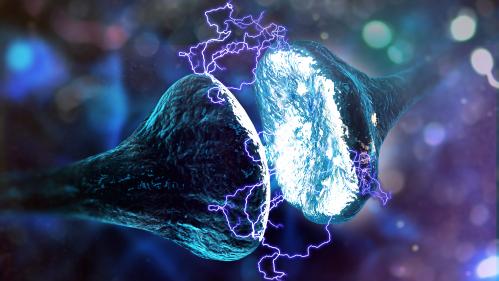Landmark Study Reveals Clearest Genetic Signals Yet for Schizophrenia Risk

This and another large genetic study, just published in Nature, point to similar genes and biological mechanisms that start to hone in on the root causes of the severe psychiatric disorder
In a landmark genetic study of more than 121,000 people, an international consortium called SCHizophrenia Exome Meta-Analysis (SCHEMA), led by researchers at the Broad Institute of MIT and Harvard, has identified extremely rare protein-disrupting mutations in 10 genes that strongly increase an individual's risk of developing schizophrenia. The Genomic Psychiatry Cohort (GPC) study, based at Rutgers, The State University of New Jersey and led by Drs. Carlos and Michele Pato, is a major contributor to this study and the second, complementary study, led by researchers at Cardiff University on behalf of the Psychiatric Genomics Consortium (PGC). The PGC study is based on a larger but overlapping group of 320,400 people and brings to 287 the number of regions of the genome associated with schizophrenia risk, including ones containing genes identified by SCHEMA.
Together, these studies underscore an emerging view of schizophrenia as a breakdown in communication at the synapse (the junction between neurons) and illustrate how different kinds of genetic variation affecting the same genes can influence the risk for different psychiatric and neurodevelopmental disorders. The two studies appear together in the journal Nature.
“The advances being made in these studies begin to clarify converging biology and physiology that can be targets for new treatment development,” explained Carlos Pato, executive chair of psychiatry at Rutgers Biomedical and Health Sciences (RBHS) and co-lead of the GPC study based at Rutgers.
Michele Pato, who is the leader of all patient assessment for the GPC and director of the Rutgers Center for Genomics of Psychiatric Health and Addiction, added, “These rare mutations have proven to converge on a typical clinical presentation. This may mean that the convergent biology in cellular signaling pathways is applicable to a much larger portion of our patients suffering from schizophrenia.”
Michele and Carlos Pato are major contributors to both the SCHEMA program and the PGC consortium.
"Identifying these 10 genes is a watershed moment in schizophrenia research because each one of them provides a solid foundation for launching biological inquiry," said Benjamin Neale, another co-corresponding author on the SCHEMA study, a PGC collaborator, an institute member and director of genetics in the Stanley Center, co-director of the institute's Program in Medical and Population Genetics, and faculty of the Mass General ATGU. "By sequencing the DNA of thousands of people, we are starting to see exactly which genes matter. These discoveries are the starting point for developing new therapies that treat the root cause of this devastating condition."
"We've tried for years and years to gain this kind of traction on the biology of schizophrenia," said Broad core institute member and Stanley Center director Steven Hyman. "Realistically, it will take yet more years to translate these results into biomarkers and treatments that will make a difference in the lives of people who are suffering with this devastating illness. But it is highly motivating to have a compelling path forward."
A global collection
The SCHEMA and PGC findings are the fruit of a decade-long push led by researchers across nearly four dozen institutions. Both projects aim to gather and compare DNA from large numbers of people with and without schizophrenia. By working together, investigators across the PGC have built a dataset that now includes more than 320,400 people from collections across the world, including people of European, Finnish, African American, LatinX, East Asian, and Ashkenazi Jewish descent. The SCHEMA cohort comprises a subset of that, representing more than 121,000 people.
The two groups have in parallel followed complementary paths in their study of schizophrenia genetics. Since 2009, the PGC team has conducted increasingly larger genome-wide association studies cataloging common genetic variations called single nucleotide polymorphisms (or SNPs) that contribute to schizophrenia risk.
The SCHEMA Consortium — which came together in 2017 — focuses on the exome, the nearly two percent of the genome encoding proteins. Specifically, the SCHEMA Consortium looked for variants that adversely affected a gene’s ability to produce healthy, functioning proteins.
According to Tarjinder Singh, a postdoctoral fellow in the Stanley Center for Psychiatric Research at the Broad Institute, these two studies were possible because the necessary pieces were finally in place. "The genomic technologies, the sequencing infrastructure, the computational tools needed to understand the data they produce, have advanced dramatically in the last two decades," he said. "The most important piece was the global commitment on the part of PGC and SCHEMA members to share samples and data across institutions and nations to achieve the numbers of people needed to bring these rare mutations to light."
Emerging convergence
By sequencing whole exomes from 24,248 people with schizophrenia and 97,322 without, the SCHEMA team identified ultra-rare variants in 10 genes that dramatically increased a person's risk of developing schizophrenia. These variants, called PTVs for “protein truncating variants,” prevent cells from producing a gene’s full-length functional protein.
"In general, any given person has a roughly one percent chance of developing schizophrenia in their lifetime," said Neale. "But if you have one of these mutations, it becomes a 10, 20, even 50 percent chance."
Their findings also hint at an additional 22 genes that also likely influence schizophrenia risk, and which may prove significant after further study. Data from the SCHEMA study are available at schema.broadinstitute.org.
Insights into two of the 10 genes, GRIN2A and GRIA3, support an emerging theory about schizophrenia's mechanistic roots. They encode portions of the glutamate receptor, a cellular antenna found at the synapse that allows neurons to receive excitatory chemical signals from neighboring neurons. Pharmacological studies have previously suggested that glutamate signaling may be involved in schizophrenia, but the SCHEMA study provides the first solid genetic evidence of this. Additionally, GRIN2A activity in the brain peaks during adolescence, around the time people suffering from schizophrenia begin to experience symptoms.
Most of the SCHEMA genes, however, have never been associated with a brain disorder or neuron-specific functions. One gene (SETD1A) is involved in transcriptional regulation. Another (CUL1) helps the cell recycle old or unneeded proteins, while yet another (XPO7) helps chaperone molecules out of the cell's nucleus. Yet in the SCHEMA analysis, PTVs in these genes drive a 20- to 52-fold increase in schizophrenia risk. (See “Effects of different genetic variants on schizophrenia risk” data dashboard.)
"We don't have a prior framework for understanding how these genes might play a role in schizophrenia," said SCHEMA co-corresponding author and PGC collaborator Mark Daly, who is also an institute member in the Stanley Center, Mass General ATGU faculty, and director of the Finnish Institute for Molecular Medicine. "These genes will ultimately lead to some new insights but are going to require a lot of experimental follow-up to see where they might fit in the puzzle."
Separately, the PGC team examined common genetic variations in 76,755 people with schizophrenia and 243,649 without, finding 287 regions of the genome (or loci) as having some involvement in schizophrenia risk, an increase of 94 loci since the last PGC analysis released in 2019. With further analysis they identified 120 genes that potentially increase risk for schizophrenia. Many of these genes were also identified in the SCHEMA study.
The PGC team also found that the regions they implicated are largely active only in neurons, only in the brain, and affect mechanisms that directly impact neuronal communications, such as synaptic structure and organization.
The nature and effect of the variants detected by PGC differed in some ways from the SCHEMA findings. For instance, the damaging protein-coding GRIN2A mutations SCHEMA identified are extremely rare and raise schizophrenia risk 24-fold. The variants found in the PGC study are far more common and change GRIN2A expression, increasing risk by only 1.06-fold.
However, the fact that both studies' findings converge on similar groups of genes and similar biological mechanisms suggests that genetic discoveries are beginning to home in on core aspects of schizophrenia biology and are close to broader insights into the mechanisms underlying schizophrenia progression.
"Our hope was that we would end up with some amount of overlap in the stories that the common and rare variant associations were telling us," said Neale. "And we see overlap pointing to a relationship between synaptic biology and schizophrenia risk."
Revelations into shared risk
The SCHEMA data also shed light on how psychiatric and neurodevelopmental disorders more broadly can share genetic risk. For instance, several SCHEMA genes, including GRIN2A, have previously been implicated with neurodevelopmental conditions such as developmental delay, intellectual disability, and autism spectrum disorders.
But by comparing their data with that of other large-scale studies, the SCHEMA team noted that the overlaps they saw were driven by different kinds of mutations: PTVs for schizophrenia, missense mutations (which can lead to amino acid swaps that modify a protein's activity) for the neurodevelopmental conditions.
"We see that a spectrum of consequences can arise from different kinds of mutation in the same genes," Neale noted. "We have a lot more to do and a lot more to learn about what these genes do, what variations in these genes do, and what the biological consequences of genetic variation really are writ large."
"This point is critical for gaining insight into how genetics works across brain disorders," Daly added. "We need to make sure that we don't take a siloed view of these data, and instead remain open to learning what these genetics has to teach us across phenotypes."
And indeed, this perspective is already bearing fruit. In a separate study published in Nature Genetics, the international Bipolar Exome Consortium (BipEx), reports comparisons of SCHEMA and BipEx data have helped reveal rare PTVs in the gene AKAP11 gene that raise the risk of bipolar disorder several-fold, making it the strongest genetic risk factor found for bipolar disorder to date.
Fitting the puzzle pieces together
Already a great deal of work is being done to model the effects of the SCHEMA mutations in the laboratory. Researchers also recognize that there are many additional genetic discoveries waiting to be found.
"These first 10 genes are really only the beginning of genetic discovery," Neale said. "There is pretty clear evidence that there are many more genes to discover using the same kind of approach. But we fundamentally need bigger sample sizes to be able to reveal those additional genes.
Brian Strom, chancellor of Rutgers Biomedical and Health Sciences, congratulated the discovery teams and said, “These are very exciting findings that pave the way for not only a clear definition of risks for schizophrenia but also for targeting specific interventions.”
Using a parallel strategy, Rutgers researchers Jennifer Mulle (associate professor of psychiatry at Rutgers Robert Wood Johnson Medical School), Zhiping Pang (associate professor of neuroscience and cell biology at Rutgers Robert Wood Johnson Medical School), Ron Hart (professor of cell biology and neuroscience at Rutgers School of Arts and Sciences), and the Patos have designed a new study based on the 65,000 participants (cases and controls) in the GPC.
“We have the unique opportunity to study individuals with highly penetrant rare copy number variant (CNV) mutations that, in most cases, cause schizophrenia,” added M. Pato, who is also professor of psychiatry at Rutgers Robert Wood Johnson Medical School and Rutgers New Jersey Medical School.
Mulle, who is also a faculty member of the Rutgers Center for Advanced Biotechnology and Medicine, explained, “These exciting data from the SCHEMA study suggest that schizophrenia-associated mutations may converge on shared pathways or targets. In this exciting project, our Rutgers team will use cutting-edge molecular neuroscience technologies to test this hypothesis of biological convergence. Our results will have the potential to lead to transformative insights into the neurobiology of schizophrenia and uncover novel targets that may be a launch point for therapeutic discovery.”
Support for the SCHEMA study was provided by grants from the National Institute of Mental Health, the National Human Genome Research Institute, the Stanley Family Foundation, Kent and Elizabeth Dauten, the Dalio Foundation, and other sources.
Support for the PGC GWAS study was provided by the National Institute of Mental Health and other sources.



